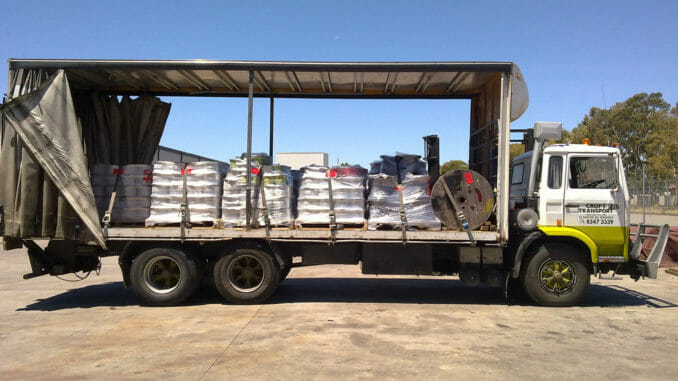
How to Decide Which Commodity to Haul When You Start Out…
Obtaining your CDL and finding that first truck driving job are great goals, but have you thought about what kind of commodity you’re going to pull behind you? There are plenty of choices and each is unique in its needs from the driver. There is a lot more to the job than just holding a wheel for eleven hours and doing a little paperwork.
The freight is the true money maker, and each commodity has its own challenges. Some loads such as refrigerated goods and livestock require a watchful eye (or ear) from the driver twenty-four hours a day, where dry van freight is pretty much “maintenance-free” once the doors are shut, locked, and sealed.
Certain types of freight, like over-sized and hazardous materials, requires a driver who is very detail-oriented as each state has different requirements to transport these commodities on public roads. Oversights can be financially costly for the driver in the form of tickets and a negative DOT safety rating which the driver is directly responsible for. Fines can be well over a thousand dollars for the first infraction.
Dry Van
Dry van freight is by far the most prominent commodity being moved on the highway today. Vans carry everything from industrial parts, clothing, recyclables, non-refrigerated food products, and anything else that fits between the doors and can be reasonably loaded by a forklift.
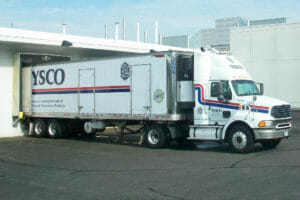
This style of freight handling is really considered “hands-free” for the driver or, in transportation lingo, “no-touch” freight.
No-touch freight reduces the liability for the driver because the driver doesn’t have to load or unload the freight by hand. The driver may be required to count the commodity being loaded, but that is even fairly rare today.
Most of the time, the driver goes in and signs the Bill of Lading after the freight is loaded, and the shipper attests to the quantity and condition of the freight loaded on the truck.
The shipper’s signature certifies that the above named materials are properly classified, packaged, marked and labeled, and that they are in proper condition for transportation. This reduces the stress on the driver, and allows the driver to focus on the other aspects of the job.
This reduction in responsibility does have its drawbacks however. Van drivers typically are on the bottom when it comes to pay. The van driver can expect to make markedly less per mile than the other specialty drivers can earn. Does this mean you can’t make money hauling van freight? No, not at all.
Specialized van freight is quickly becoming the money maker in the transportation industry. Many truck drivers assume that hauling hazardous materials is a fast track to making lots of money, but that isn’t always true.
Refrigerated, or “Reefer”
Refrigerated transport pays slightly more than that of dry van freight, but it requires substantially more responsibility from the individual driver. While some challenges for the driver have been made easier with the advent of technology in the industry, the shippers and receivers have become increasingly more stringent on their expectations as well.
In the last two decades, the refrigerated transportation industry has seen major changes in the ability to monitor and control the temperature of the product, and this has placed additional duties on the driver. Drivers must still fill the trailer fuel tank and keep an eye on the temperature, but now they also bear responsibility for how the freight is loaded.
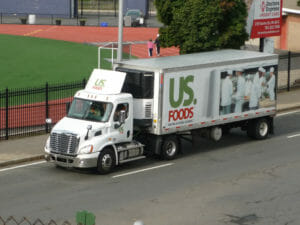
The cold air flow over the freight has to be maximized because now the loads contain “telltale” devices throughout the trailer. These devices tell the receiver what the temperature of the load has been since it left the shipper.
If there is a variance of only a few degrees, then the receiver can (and will) refuse the whole load. The driver then has to deal with the fallout. A few refused loads, whether they are the driver’s fault or not, can result in the driver getting fired.
The refrigerated transportation of goods does have its perks, though. Nothing is more refreshing then opening a cold load in the summer time and feeling the cool blast of air fall from the trailer.
Working in a temperature-controlled environment when the weather is at its extremes has always been enjoyable.
Most of the loads that refrigerated freight carriers handle are foodstuffs. When there is a damaged good, the receiver usually refuses it and then the trucking company tells the driver to discard it. Drivers often times get to “dispose” of this freight as they deem necessary. Sometimes they keep it, and sometimes they donate it to local shelters. The look on the faces of these homeless shelter workers when the driver pulls up with 10-15 cases of canned goods is priceless and worth more than money can ever buy.
If there is a failure of the refrigerated equipment for the trailer, then it’s the drivers responsibility to notify the company to get it fixed immediately, so that the load is not jeopardized. This is the most stressful part of the job because most equipment failures don’t happen when the driver is alert or even awake. Some equipment manufacturers have designed warning devices for inside the cab, so that if there is a problem with the load, the driver knows right away. Unfortunately, only certain companies have this equipment.
An equipment breakdown is not necessarily the driver’s fault, but trucking companies do scrutinize how the driver deals with these problems. If the company feels the driver procrastinated in communicating a failure, then the driver will be held responsible. These companies tend to pay more for the additional stress placed on the driver.
Flatbed
Flatbed, heavy haul, and step deck make up the three subdivisions of the flatbed industry. Each one requires an agile driver who has a basic understanding of physics because it is very “hands on” when securing the freight and maintaining the load until delivery.
Flatbed, heavy haul, and step deck are markedly different in their approach to driver pay, and the drivers are placed under different confines which define their occupation. Flatbed trailers are just that, flat. They range from 28 to 53 feet long. Loads that are typically shipped on flatbed trailers are longer then what a step deck trailer are capable of hailing.
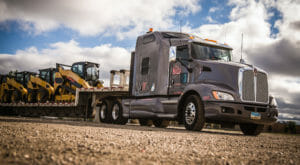
Step deck trailers are typically 48 to 53 foot long, but they have a markedly lower “main deck” that is connected to a shorter “top deck” that is located over the drive tires of the tractor.
Step-deck trailers are great for loading a variety of commodities, from small-wheeled vehicles to other industrial loads where the total length of the load will allow it to be separated in between both decks.
They have a lower center of gravity as the main deck is 24-26” off the ground rather then a flatbed’s 48” typical ride height. This allows for taller loads to be loaded before special “oversize” permits are needed.
Heavy haul is the most specialized version of a flatbed-type job. As the name implies, these open style trailers are specially designed to haul weights over the standard 80,000lb gross weight. These drivers are the ones who are constantly dealing with paperwork, permits, and specialized equipment.
Flatbed and step-deck loads place a lot of responsibility on the driver for both loading and properly securing the loads. The driver dictates how they want the load positioned for both weight distribution and securement. The driver is 100% responsible for securing the load per DOT requirements and weight distribution requirements. The driver is also responsible to tarp the load if the customer requires it. These responsibilities are physically demanding and require an understanding of physics to know how the securement will affect the load.
Pay for flatbed and step-deck drivers can vary by company, but most pay more than both van and refrigerated because of the additional responsibilities placed on the driver. Flatbed loads are more relaxed on their delivery requirements than either van or refrigerated because of these time-consuming responsibilities placed on the driver; and the receiving companies are more understanding of a delayed shipment due to securement requirements.
The common feeling with the receiving companies is that they would much rather receive their delivery undamaged, and in one piece, then have to order a replacement. Some flatbed deliveries, though, must still be made on a strict schedule as construction projects and other industries are on a tight schedule.
Tanker
Bulk material transport, whether dry or wet, is referred to as a tanker. To haul this material requires a tank trailer endorsement. Tanker truck drivers tend to benefit from a substantial increase in pay (per actual mile driven) due to the additional responsibilities placed on them. The length of unload, the danger of the product, and the times at which the product needs to be delivered all vary along the product itself.
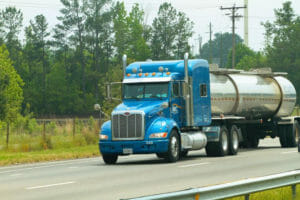
Some tanker products require hours of unload and load time, and the driver is typically required to stand by while this process happens.
Liquids such as gasoline unload rather quickly, but if you are hauling a thick liquid, such as corn syrup, then the viscosity will lengthen the unload time.
All of this “on-duty” time eats into the drivers actual ability to drive, but the driver has to be compensated for it.
Companies who haul these commodities generally have lucrative pay packages for the drivers that includes unload, detention pay, and extended load time.
Research done by the prospective driver will ensure that the pay package is right for them. Drivers who drive tankers are typically more experienced because most tank transport companies require a certain level of driving experience. If you can find a trucking company that doesn’t require much experience for tanker, those jobs make an excellent high-paying starting point for a new driver.
Hazardous Materials, or HAZMAT
When it recently became more difficult to obtain a HAZMAT endorsement, the common thought was that the rates for HAZMAT are about to skyrocket and the drivers will see an increase in pay. This hasn’t really materialized as fast as was commonly expected. Yes, the pay rates went up some, but, at the same time, the fuel prices went up and soaked up a lot of the additional revenue the companies were receiving.
Nonetheless, HAZMAT remains one of the higher paying endorsements, but it also carries the danger of transporting hazardous materials. Many HAZMAT trucking jobs require the tanker endorsement as well.
A Note for the Future: LTL
A hidden gem in the trucking industry has been an increase in the number of jobs for LTL and regional moves. The “Less than Truck load,” or LTL, business is booming, and drivers are at a premium. Most LTL positions are local or regional, but there are LTL drivers (especially teams) who “run the circuit” (especially around the holidays as this is the busiest time for LTL carriers), and these drivers will stay out for weeks at a time. Regional LTL drivers can stay away from home for a night to 3-4 days.
These jobs are not for beginners, though. You can’t count on these jobs being available to you for your first 100,000 miles. Most LTL and regional driving jobs, especially from companies like FedEx and UPS, want driving experience, which means over-the-road (OTR), or long-haul.
Summary
Listing the general differences between freight can only go so far as to explain the pay structure for new drivers because pay scales vary immensely in the transportation industry. These differences in the freight do, however, have a single unifying factor. Generally, the more responsibility that is placed on the driver to successfully deliver a damage-free load, the more the driver is compensated for their time. Your own needs for responsibility, risk, routes, and pay will ultimately determine which freight is best for you.
